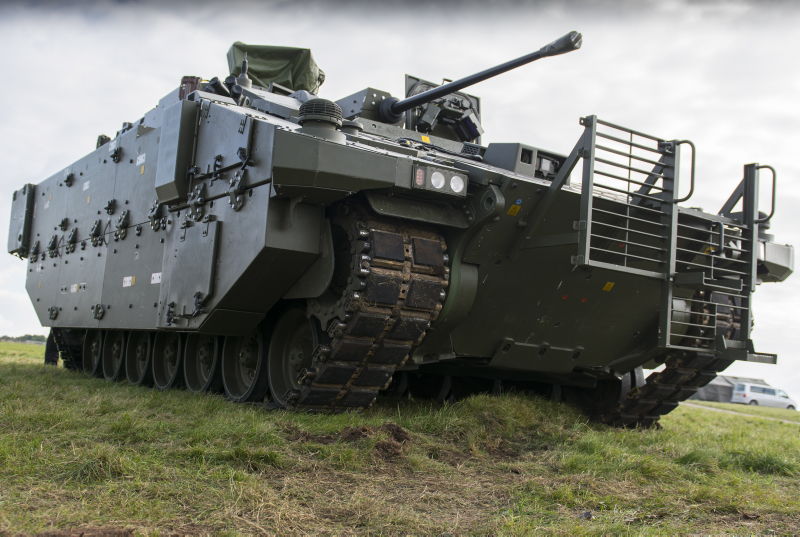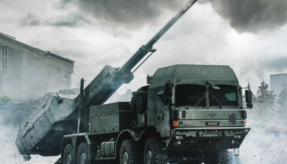
Speech delivered by Secretary of State for Defence Sir Michael Fallon at the RUSI Landwarfare Conference.

Image: © Twocoms / Shutterstock.com
It’s a great pleasure to be here and to return as the Defence Secretary.
I have a slightly strange record in that this is the fourth time in three years I’ve been appointed for this job.
Truly, as our conference theme reminds us, we are living in an age of constant competition!
Yet, if we really want to understand what the phrase means, we need to take a step back.
100 years ago our main dangers came from rival nations threatening us with conventional war.
The Army was expected to play a pivotal role fighting at close range.
It did so with unprecedented courage amidst the mud and blood of monumental battles such as Passchendaele which we will commensurate shortly.
But the Cold War introduced another level of threat – the shocking prospect of nuclear war.
Our deterrent relied not just on nuclear submarines, or NATO partnerships, but also we shouldn’t forget the physical presence of our troops, ranging ever ready along the frontiers of the iron curtain.
Yet globalisation and the relentless advance of technology are today posing our nations a very different set of problems.
We have state aggressors like Russia testing our allies along Europe’s eastern border using proxies to destabilise Ukraine and annex Crimea and deploying hybrid means to undermine democracy in countries far and wide.
And then we have non-state actors.
Those lacking the power to threaten our nation as a whole, but intent on causing us as much carnage as possible as we’ve seen so recently – in Westminster, Manchester, London Bridge and Finsbury Park.
And we have anonymous cyber foes – often sponsored by state or non-state entities, lurking behind a veil of encryption targeting our national infrastructure as we saw with the recent cyber strike on Parliament.
That is not a Cold War.
It is a grey war. Permanently teetering on the edge of outright hostility. Persistently hovering around the threshold of what we wouldn normally consider acts of war.
IMPLICATIONS FOR LAND POWER
What does that mean for land power?
We will still look to you to seize and hold territory to fight in close proximity with…and among the population since our willingness to employ land power is critical to our deterrent.
Yet the question is neither about how or when we respond with appropriate force since we will do so at a time and in the manner of our choosing.
Instead the real question is how we retain enough room for manoeuvre, as equipment costs escalate and the demands, from a multitude of diverse, complex and concurrent dangers, grow.
And my thesis today is that the only way our armies can prepare for the battlefields of tomorrow is by placing innovation and adaptability at their core.
INVESTMENT
That will require investment.
We’ve chosen in UK to spend on bigger, bolder defence, increasing our budget year on year…at 0.5 per cent ahead of inflation.
In 2016 our forces received some £35bn.
This year it will be £36bn.
And next year it will be £37bn.
But having more money doesn’t mean we can do everything we want
It has always been, it always will be a question of prioritisation.
Thanks to the delegated model Service Chiefs have responsibility, accountability and authority for their own budgets.
And I know that the Army feels incentivised to review its processes and structures to find more efficient, smarter and more productive, ways of doing things so they can reinvest in new projects to keep us on the cutting edge.
At the same time, the Service Chiefs know that delivering some programmes will be contingent on making efficiency savings.
This helps us focus so, by the time, we reach our Annual Budget Cycle we are concentrating not on the nice-to-haves but having more money for the things we need the most.
And thanks to those decisions we now have a much clearer sense of the things that really matter:
- PLATFORMS
First, platforms.
The history of landwarfare is punctuated by moments of brilliance, instances where innovation and imagination changed the course of operations.
So the longbow, became the musket, became the machine gun.
The chariot gave way to the cavalryman.
And then a century ago at Cambrai the tank reached the Hindenburg line, triggering another revolution in warfare.
So today we’re using our £178bn equipment programme as the catalyst for a further step-change in capability as we introduce Ajax.
Ajax is more than just a piece of armour.
Ajax is an Information Age sensor. Able to hoover up data from the ground and air for miles around. Capable of detecting the invisible signs of cyber disturbance. Able to offer a more complete picture of an increasingly dispersed battle space, while co-ordinating our response with the wider force.
And AJAX isn’t the only bit of capability we’re bringing on line.
We are using our rising budget to invest in a whole raft of high-tech capability, unmanned aerial systems, autonomous vehicles and Apache attack helicopters.
Today I’m delighted to announce we have awarded a £48m six-year contract extension with Aviation Training International, to enable our ground crews to master all there is to know about this mighty flying machine. From avionics and armaments, to refuelling and rearming.
In a couple of months’ time we will be showcasing some of this next generation kit at DSEI.
These investments are not just about replacing old kit.
We now are buying equipment that gives us far more bang for our buck.
In a data driven era investment in vehicles of course must go hand in hand with an investment in networks
That’s why we’re enormously augmenting our processing power to handle the massive upload of new information
We’ve already taken the first step.
We are investing in MORPHEUS, a next-generation tactical communication and information system that will give us faster and easier connectivity.
In the longer-term, our Land environment tactical command and information system will eventually connect all of our sensors and systems.
- PEOPLE
Of course, great kit alone doesn’t guarantee an agile and adaptable Army.
So the second major investment has to be in people.
Before I continue I want to say that our thoughts and prayers are with the families and friends of Corporals Matthew Hatfield and Darren Neilson of the Royal Tank Regiment who died after a live firing exercise in Castlemartin on 14th June, and the other two soldiers who were injured in the same deeply sad incident.
The investigation is on-going but we are determined to get to the bottom of this tragic accident because our people are our greatest asset.
That’s why we remain committed to maintaining the overall size of the Armed Forces and an Army capable of fielding a warfighting division.
Mass will always be a vital part of our deterrence.
So we will maintain an Army that remains one of the very few nations in the world capable of fielding that warfighting Division.
And when it comes to Reserves our confidence in our Reserves plans is reflected by the fact that the Infrastructure and Projects Authority has recently taken the Army Reserves Programme off its books – the only programme to be so assured in the last 5 years.
But, in a more competitive labour marketplace, it becomes even harder to retain, retrain and recruit the right people with the right mix of skills.
So let me say a word on each of these.
On retention – our flexible engagement reforms championed by Sir Nicholas Carter…are key. Our new legislation will be published tomorrow.
We are going to make it easier for personnel to temporarily change the nature of their service, to give them a chance to work part-time or be temporarily protected from deployment to support an individual’s personal circumstances where operational need allows. That’s retention.
On to training.
The battle for information and influence will increasingly matter, so our soldiers will need to have a raft of new skills.
Becoming more adept at crunching the data churned out by their equipment.
More aware of what that information means.
More able to make swifter, better informed decisions
And we will need to increase our training in counter reconnaissance, because the information environment is far from being a passive space is now a hotly contested battleground, where we are constantly competing to correct the false narrative of our adversaries with a faster truth.
For that to happen, the Army will need to keep adapting its structures.
We’re starting today.
I can announce that we are now bringing the Royal Signals and Intelligence Corps together under a shared command.
The Intelligence Corps off course packages, collates and analyses vital information on the battlefield.
The Royal Corps of Signals provides the state-of-the-art technology to disseminate information quickly, in an agile way.
Working together those two Corps will bring a laser-like focus and co-ordination to our cyber efforts.
That’s retention and retraining, finally to recruitment.
There is a challenge here that I want to set before this conference.
We know we will need to reach out to the brilliant brains of tomorrow
Those who put apps above artillery, who pride brains above bayonets.
We know we have to maintain the Army as an attractive proposition for those who might not have normally considered a military career – the cyber geeks and tech wizards.
The question is how do we attract that element in the new generation?
Let me put forward a few initial thoughts to frame your discussions.
We’ll need to do more with our Reservists, more with our Whole Force of civilians and industrialists because they bring a fresh injection of new ideas, new approaches and outside expertise.
Second, we must also be more open to challenge from the younger generation
The Army is an institution. rightly reveres its great traditions but when they tell us, for example, that there are savvier ways for us communicate – let’s listen.
I’m glad that in the earlier session we laid down a marker here by inviting our juniors delegates to come up and show us a thing or two.
- PARTNERSHIPS
My final point is that an agile Army of the future requires strong partnerships sharing the burden of complex global challenges.
Our 2015 SDSR set us the challenge of becoming more international-by-design.
So, even as we step back from the political framework of EU, you will find us sticking by that plan and stepping up to confront those global challenges.
That’s why we will strengthen our commitment to NATO, the cornerstone of defence.
By increasing our budget year on year, we’re not just about fielding a division but to put our troops at the service of the Alliance.
Currently, the Army is heading up NATO’s Very High Readiness Joint Taskforce.
A couple of weeks ago I saw it in action in Romania, partnering with 14 other nations in Exercise Noble Jump.
At the same time, our troops are leading our Enhanced Forward Presence in Estonia and Poland. By the end of this month we’ll have 10,000 soldiers supporting the NATO Alliance in one way or another.
Yet our efforts here show how we’re getting smarter as we adapt to the new era of competition.
We are not just using training and exercises to get our people in shape, but to deliver strategic effects
Messages of reassurance to our allies.
Messages of deterrence to our adversaries.
But if we want to be really smart we have to be able to spot a crisis before it turns into a catastrophe.
Or better still before it even arises.
That’s why we’re creating those Specialised Infantry teams.
Invested with specialist skills relevant to different parts of the globe.
There to sense danger, to provide early warning, to build the partnerships that head off trouble down the track.
And for proof of our commitment to keep reaching out you only need to look around the room.
This might be a UK land warfare conference, but we have here a huge number of guests drawn from our allies around the world.
You’re very welcome.
PUBLIC
So platforms, people and partnerships are the key to us, the agile edge we need in this era of constant competition.
But we need to take the public with us on this journey.
Since the end of our Afghanistan and Iraq fighting campaigns, the public no longer has the same level of awareness about what our Armies are up to.
As the threats become ever greyer and murkier, as our responses necessarily become sometimes more opaque, as our adversaries become ever more effective at using misinformation to play upon public fears, it’s all the more incumbent on us to shine the light of transparency.
On this new greyer dawn, reassuring people that we’re on the case, showing them we do have the means to respond, that there is not simply a cost but a real value to what we do.
That’s why the public discourse, why open debate and why conferences such as this are so vital.
CONCLUSION
A century ago, after years of stalemate, that Mark IV tank burst through the Hindenberg Line.
An event that wouldn’t just lead to the Allied Armies winning the war but to war itself being transformed.
Today we are living in an age of instability, an age of constant competition.
But the answer is for our Armies keep adapting, to keep becoming truly agile.
Image: © Crown Copyright
Army Defence Secretary Sir Michael Fallon Land landwarfare NATO RUSI RUSI Landwarfare conference








